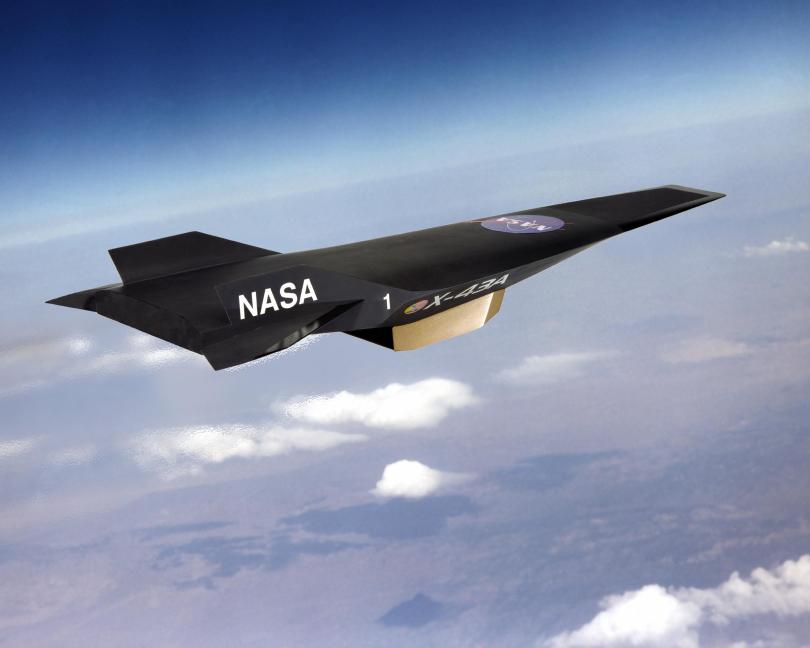The Arms race towards hypersonic weapons
INTRODUCTION
In 2004, NASA’s hypersonic scramjet-powered aircraft X-43A hit a record-breaking speed of Mach 9.6. As one of the most promising propulsive systems, the scramjet engine has drawn the attention of many researchers in the recent years. The development of efficient propulsion systems capable of producing large thrusts is the key to the success of hypersonic vehicle development programs.
WORKING PRINCIPLE
Scramjets or supersonic combustion ramjet are engines designed to operate at high speeds, and usually, they are powered by hydrogen fuel. Theoretical projections place the top speed between Mach 12 and Mac. The major components of a scramjet engine are an inlet, combustion chamber, and exhaust. These are engines designed to operate at high speeds, usually only associated with rockets, and are typically powered by hydrogen fuel.
The major components of a scramjet engine are an inlet, combustion chamber, and exhaust. These are engines designed to operate at high speeds, usually only associated with rockets, and are typically powered by hydrogen fuel.

A scramjet has no moving parts. When the aircraft moves with supersonic velocity, say Mach 4, the air is rammed inside the scramjet engine. Air entering the intake is compressed using the forward speed of the aircraft. The intake air is then slowed from supersonic to low subsonic speeds by aerodynamic diffusion created by the inlet and diffuser. The temperature and pressure of the air increase due to the formation of oblique shock waves. This compressed-air moves towards the combustion chamber, where the hydrogen fuel is injected. The flow field inside a scramjet combustor is highly complex. The mixing of reactants, flame holding, stability, and combustion completion are the primary concerns in supersonic speed in the combustion chamber. The burning of fuel leading to the expansion of hot gases generate enough thrust to overcome the drag forces, and you can get around Mach ten at the exhaust. This results in a forward velocity.
The geometry is simple and can attain very high velocity since the scramjet doesn’t have moving parts like the compressors or turbines like a typical jet engine. But the drawback is that this engine can’t be used when the vehicle is at rest since it uses its forward speed to compress the air. Hence, we can say that the scramjet engine cannot function independently and other propulsion engines have to be used to get the aircraft to reach the supersonic speed. And since the air is traveling at a very high speed, the mixing of fuel and air should take place in a fraction of a second, resulting in fuel wastage.

The efficiency of jet engines is measured by the specific impulse, the ratio of the thrust to the second fuel consumption. From figure 2, we notice that the rocket engine’s specific impulse is much lesser than the air-jet engines. This is because the oxidant is also included in the fuel consumption of the rocket engine, whereas the air-jet engine takes from the atmosphere. In connection with this, the scramjet engines can create hypersonic aircraft, which could dramatically reduce the time of flight from one place to another. These engines could be the first step in creating reusable accelerators to launch missiles into space and inject heavier satellites into orbit.
RECENT DEVELOPMENTS
Advances in scramjet technology could positively impact the global hypersonic technology market. India started its efforts on scramjet technology long back, and ground testing was done in 2006 to validate the engine’s design. Russia was the first country to claim the scramjet flight test in 1991, followed by the US and European Space Agency, and now, India has become the fourth country to claim the successful testing of the engine. In 2020, India tested a hypersonic technology demonstrator vehicle, and DRDO is currently developing a Brahmos II cruise missile based on a scramjet engine. In a nutshell, the development of scramjet technology is an important milestone in ISRO’s endeavor towards its future space transportation systems. The growth of reliable scramjet engines will prompt the expansion of hypersonic technologies, and thus, it will propel the rise of the global market in the future.
REFERENCES
https://en.wikipedia.org/wiki/Scramjet#Applications
https://www.thehansindia.com/posts/index/Education-andCareers/2016-07-22/Scramjet-Engine/243771
https://www.isro.gov.in/launchers/isro%E2%80%99s-scramjet-enginetechnology-demonstrator-successfully-flight-testeds


